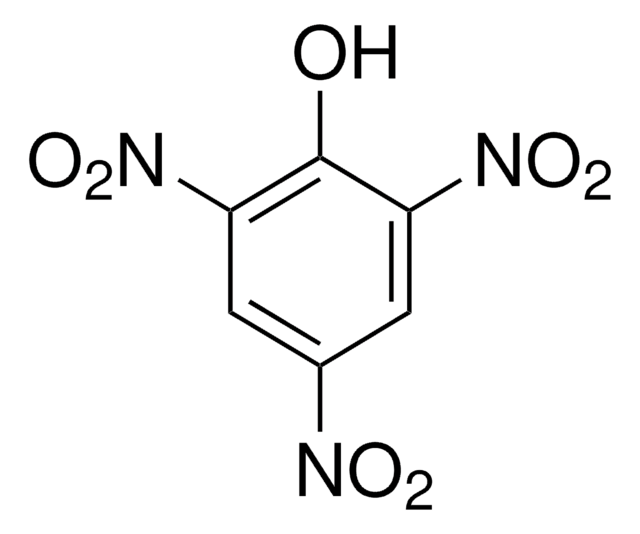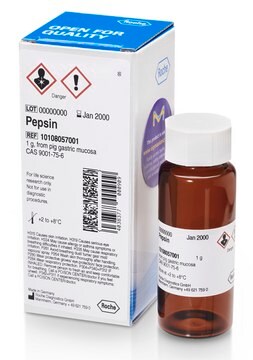80518
Sodium thiocyanate solution
BioUltra, 8 M in H2O
Synonym(s):
Sodium rhodanide solution
About This Item
Recommended Products
product line
BioUltra
Quality Level
form
liquid
concentration
8 M in H2O
impurities
insoluble matter, passes filter test
pH
5-8 (25 °C, 8 M in H2O)
solubility
H2O: 8 M at 20 °C, clear, colorless
density
1.295 g/mL at 20 °C
anion traces
chloride (Cl-): ≤50 mg/kg
sulfate (SO42-): ≤100 mg/kg
sulfide (S2-): ≤20 mg/kg
cation traces
Al: ≤1 mg/kg
As: ≤0.1 mg/kg
Ba: ≤1 mg/kg
Bi: ≤1 mg/kg
Ca: ≤50 mg/kg
Cd: ≤1 mg/kg
Co: ≤1 mg/kg
Cr: ≤1 mg/kg
Cu: ≤1 mg/kg
Fe: ≤1 mg/kg
K: ≤200 mg/kg
Li: ≤1 mg/kg
Mg: ≤1 mg/kg
Mn: ≤1 mg/kg
Mo: ≤1 mg/kg
NH4+: ≤40 mg/kg
Ni: ≤1 mg/kg
Pb: ≤1 mg/kg
Sr: ≤1 mg/kg
Zn: ≤1 mg/kg
absorption
cut-off at 276 nm in H2O at 8 M
SMILES string
[Na+].[N-]=C=S
InChI
1S/CHNS.Na/c2-1-3;/h3H;/q;+1/p-1
InChI key
VGTPCRGMBIAPIM-UHFFFAOYSA-M
Looking for similar products? Visit Product Comparison Guide
Related Categories
Application
- Investigation of supramolecular structures in various aqueous solutions of an amyloid forming peptide using small-angle X-ray scattering.: Sodium thiocyanate solution was utilized to investigate the supramolecular structures of amyloid-forming peptides, providing insights into amyloid diseases and potential therapeutic approaches (Brunzell et al., 2024).
signalword
Danger
Hazard Classifications
Acute Tox. 4 Dermal - Acute Tox. 4 Inhalation - Acute Tox. 4 Oral - Aquatic Chronic 3 - Eye Dam. 1
supp_hazards
Storage Class
10 - Combustible liquids
wgk_germany
WGK 1
flash_point_f
Not applicable
flash_point_c
Not applicable
ppe
Eyeshields, Faceshields, Gloves, type ABEK (EN14387) respirator filter
Certificates of Analysis (COA)
Search for Certificates of Analysis (COA) by entering the products Lot/Batch Number. Lot and Batch Numbers can be found on a product’s label following the words ‘Lot’ or ‘Batch’.
Already Own This Product?
Find documentation for the products that you have recently purchased in the Document Library.
Customers Also Viewed
Our team of scientists has experience in all areas of research including Life Science, Material Science, Chemical Synthesis, Chromatography, Analytical and many others.
Contact Technical Service











